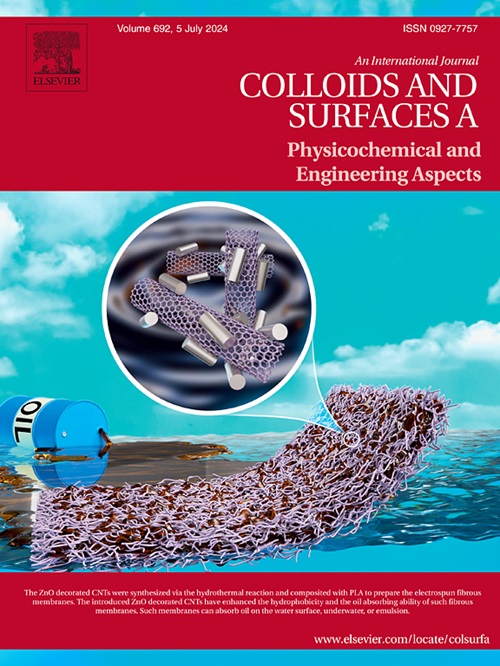利用 Y-MOF 衍生的 Y2O3/YS@C 异质结制造锂-S 电池隔膜
IF 4.9
2区 化学
Q2 CHEMISTRY, PHYSICAL
Colloids and Surfaces A: Physicochemical and Engineering Aspects
Pub Date : 2024-11-12
DOI:10.1016/j.colsurfa.2024.135750
引用次数: 0
摘要
由于锂硫电池具有出色的能量密度和比容量,因此被认为是最有前途的储能设备之一。然而,多硫化物的穿梭效应和缓慢转化大大阻碍了锂硫电池的实际应用。为了解决多硫化物的穿梭效应,我们利用 Y-MOF 衍生物 Y2O3/YS@C 复合材料作为锂-S 电池隔膜的改性层。首先,我们将四羟基乙酸钇和间苯二甲酸在溶液中反应合成 Y-MOF。随后,我们用硫代乙酰胺对 Y-MOF 前驱体进行硫化,并对其进行高温热处理,得到 Y2O3/YS@C 复合材料。金属硫化物对硫的强亲和力为多硫化物提供了化学锚定能力,而异质结构则能将非异质区域耦合在一起,产生协同效应,更好地催化多硫化物。通过使用 Y2O3/YS@C 作为分离改性剂,我们有效地抑制了多硫化物的穿梭效应,提高了电化学性能。当硫含量为 3 mg cm-2 时,Y2O3/YS@C 分离剂在 0.5 C 下的初始放电比容量为 966.1 mAh g-1;经过 400 个循环后,其放电比容量仍保持在 530.5 mAh g-1,容量保持率为 54.9%。当硫含量增加到 5 mg cm-2 时,在 0.l C 下的第一周期放电比容量为 831.4 mAh g-1;100 个周期后,比容量仍为 738.7 mAh g-1,容量保持率为 88.8%。本文章由计算机程序翻译,如有差异,请以英文原文为准。
Utilization of Y-MOF-derived Y2O3/YS@C heterojunction for Li-S battery separators
Due to its exceptional energy density and specific capacity, the lithium-sulfur battery is considered one of the most promising energy storage devices. However, the practical use of Li-S batteries is significantly hindered by both the shuttle effect and slow conversion of polysulfides. In order to address the shuttle effect of polysulfides, we utilized a Y-MOF derivative Y2O3/YS@C composite material as a modifier layer for Li-S battery separators. Initially, we synthesized Y-MOF by reacting tetra-hydroxyacetate yttrium and isophthalic acid in a solution. Subsequently, we sulfurized the Y-MOF precursor with thioacetamide and heat-treated it at high temperature to obtain Y2O3/YS@C composite material. The strong affinity of metal sulfides for sulfur provides chemical anchoring ability for polysulfide, while the heterogeneous structure can couple non-homogeneous regions together to produce synergistic effects and better catalyze polysulfides. By using Y2O3/YS@C as a separator modifier, we effectively suppressed the shuttle effect of polysulfides and improved electrochemical performance. At 3 mg cm−2 sulfur loading, the initial discharge specific capacity of the Y2O3/YS@C separator at 0.5 C was 966.1 mAh g−1; after 400 cycles, it still maintained a discharge specific capacity of 530.5 mAh g−1 with a capacity retention rate of 54.9 %. When increasing sulfur loading to 5 mg cm−2, the first-cycle discharge specific capacity at 0.l C was 831.4 mAh g−1; after 100 cycles, it was still 738.7 mAh g−1, with a capacity retention rate of 88.8 %.
求助全文
通过发布文献求助,成功后即可免费获取论文全文。
去求助
来源期刊
CiteScore
8.70
自引率
9.60%
发文量
2421
审稿时长
56 days
期刊介绍:
Colloids and Surfaces A: Physicochemical and Engineering Aspects is an international journal devoted to the science underlying applications of colloids and interfacial phenomena.
The journal aims at publishing high quality research papers featuring new materials or new insights into the role of colloid and interface science in (for example) food, energy, minerals processing, pharmaceuticals or the environment.

 求助内容:
求助内容: 应助结果提醒方式:
应助结果提醒方式:


